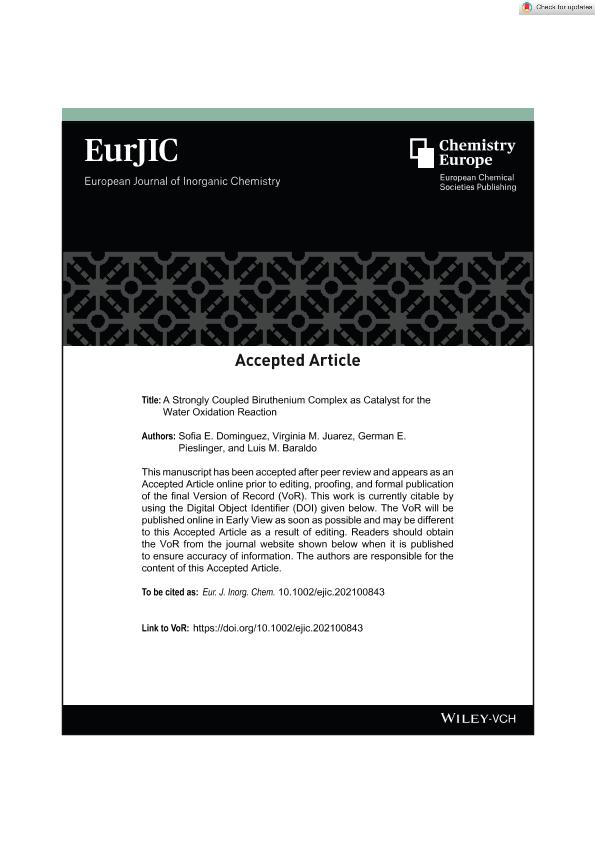Artículo
A Strongly Coupled Biruthenium Complex as Catalyst for the Water Oxidation Reaction
Domínguez, Sofía Eugenia ; Juárez, María Virginia
; Juárez, María Virginia ; Pieslinger, German Eduardo
; Pieslinger, German Eduardo ; Baraldo Victorica, Luis Mario
; Baraldo Victorica, Luis Mario
 ; Juárez, María Virginia
; Juárez, María Virginia ; Pieslinger, German Eduardo
; Pieslinger, German Eduardo ; Baraldo Victorica, Luis Mario
; Baraldo Victorica, Luis Mario
Fecha de publicación:
12/2021
Editorial:
Wiley VCH Verlag
Revista:
European Journal of Inorganic Chemistry
ISSN:
1434-1948
Idioma:
Inglés
Tipo de recurso:
Artículo publicado
Clasificación temática:
Resumen
The catalytic activity towards water oxidation of a strongly coupled bimetallic ruthenium complex, trans-[Ru(tpy)(bpy)(μ-CN)Ru(py)4(OH2)]3+ (RuIIRuIIOH2), where tpy=2,2′:6′,2’’-terpyridine, bpy=2,2′-bipyridine and py=pyridine are presented. At pH 1 the first two oxidation reactions are centred at the aquo fragment and result in the RuIIRuIIIOH2 and RuIIRuIVO redox states as confirmed by its spectroscopy and DFT calculations. Oxidation by an additional electron is followed by an irreversible step and a catalytic wave associated with the water oxidation reaction. At pH 1 the reaction with an excess of Ce(IV) results in the generation of an stoichiometric amount of oxygen based on molar amounts of the added Ce(IV). The dominant species during the catalytic cycle is the three-electron oxidized product, RuIIIRuIVO. The reduction of the concentration of Ce(IV) monitored at 370 nm follow the rate equation, −d[Ce(IV)]/dt=kox[Ce(IV)][RuIIRuIIOH2] with a kox=82±3 M−1s−1 at T=298 K. The RuIIIRuIVO species is not stable and reacts to give RuIIRuIVO.
Archivos asociados
Licencia
Identificadores
Colecciones
Articulos(INQUIMAE)
Articulos de INST.D/QUIM FIS D/L MATERIALES MEDIOAMB Y ENERGIA
Articulos de INST.D/QUIM FIS D/L MATERIALES MEDIOAMB Y ENERGIA
Articulos(IQUIFIB)
Articulos de INST.DE QUIMICA Y FISICO-QUIMICA BIOLOGICAS "PROF. ALEJANDRO C. PALADINI"
Articulos de INST.DE QUIMICA Y FISICO-QUIMICA BIOLOGICAS "PROF. ALEJANDRO C. PALADINI"
Citación
Domínguez, Sofía Eugenia; Juárez, María Virginia; Pieslinger, German Eduardo; Baraldo Victorica, Luis Mario; A Strongly Coupled Biruthenium Complex as Catalyst for the Water Oxidation Reaction; Wiley VCH Verlag; European Journal of Inorganic Chemistry; 2022; 1; 12-2021; 1-12
Compartir
Altmétricas



